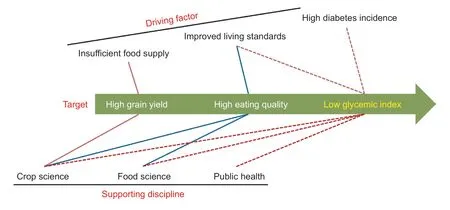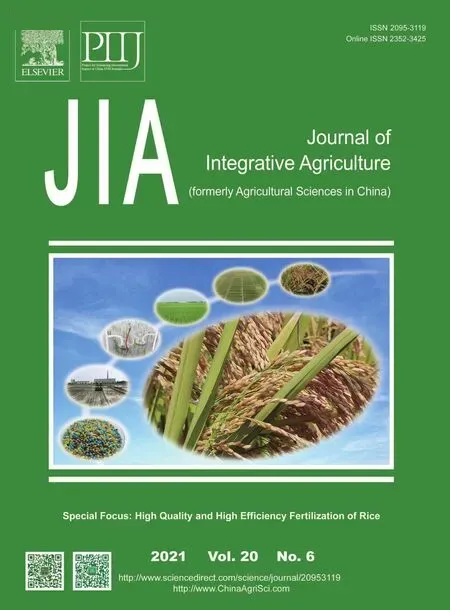Low glycemic index:The next target for rice production in China?
2021-05-23
Crop and Environment Research Center for Human Health,College of Agronomy,Hunan Agricultural University,Changsha 410128,P.R.China
China has 22% of the world’s population but only 7% of the world’s arable land. Food security has been a chief mission of the Chinese state since the beginning of the dynastic era and remains a primary objective in the early 21st century.As a result,high yield has been the first priority of farmers,researchers and agricultural agencies in China for a long time.
Rice is the most important food crop in China,feeding about 65% of the national population. Rice self-sufficiency has been achieved in China by increasing grain yields by more than 50% since 1980,and this trend is likely to be sustained assuming current yield and consumption trajectories without reduction in production area (Denget al.2019).
As living standards improve,the demand for high quality rice,especially good taste rice,increases in China. In general,rice with low amylose content and soft texture is preferred by Chinese rice consumers. This preference has driven considerable changes in rice production of China:(1)in single-season rice cropping regions such as Jiangsu and Heilongjiang provinces,the planting area of softjaponicarice with low amylose content (<15%) has increased substantially while that of non-softjaponicarice with relatively high amylose content has decreased considerably (Zhuet al.2015);(2) in single-and double-season (early and late seasons) rice mixed cropping regions such as Hunan and Jiangxi provinces,the planting area of early-seasonindicarice,which is dominated by cultivars with high amylose content (Yinet al.2020),has decreased sharply (Peng 2016),whereas the planting area of single-and late-seasonindicarice with moderate to low amylose contents has increased significantly. Increasing eating quality of rice has also been a focus for Chinese rice researchers and agricultural agencies.New tasty (soft texture)indicaandjaponicarice cultivars have been increasingly developed and grown in China to cater to consumer preferences (Zenget al.2019).
Improved living standards are also driving up the demand for healthy food in China. However,rice is generally categorized as a food with high glycemic index (GI). There is an evidence that rice consumption is significanlty positively associated with the increase in risk of type II diabetes,especially in Asian populations including Chinese (Huet al.2012). Based on the dose-response relation between rice intake and relative risk of type II diabetes plotted by Huet al.(2012),Songet al.(2017) found that the relative risk of type II diabetes was significantly elevated above 1.00 in China under the current rice intake,i.e.,213 and 256 g d–1for women and men,respectively. In addition,China currently has the highest number of people with diabetes(mainly type II diabetes) in the world,with 114 million or 12% of Chinese adults being diagnosed with diabetes and an additional 493 million with pre-diabetes (Xuet al.2013).It is well known that diet management is very important for diabetes care (Samiet al.2017). Choosing low-GI foods in place of high-GI foods is a clinically useful way to control glycemic levels in people with diabetes (Brand-Milleret al.2003). Therefore,it is meaningful and urgent to produce low-GI rice in China to reduce risk of type II diabetes. In this regard,it has been found that there is a large variability in GI among rice cultivars. For example,Fitzgeraldet al.(2011) reported that the GI of cooked rice ranged from 48 to 92 in a set of 235 cultivars.
Our concern is that the current rapid development of tasty rice with soft texture (low amylose content) may increase rather than reduce the risk of type II diabetes in China,because the lower the amylose content of rice,the lower the resistant starch contents (Rahmanet al.2007),the less the resistance to digestion (Huet al.2004),and the higher the GI (Fitzgeraldet al.2011). This concern can be supported by a human diet study of Ohtsuboet al.(2016),who observed that a more drastic increase of postprandial blood glucose occurred in the case of eating low-amylose rice than in the case of eating high-amylose rice and thus concluded that the high-amylose rice is promising for the purpose of diabetes prevention. Our concern is also supported by a population-based study of 3 918 Chinese adults aged 23–69 years (Chenget al.2017),which showed that the consumption of rice with high GI was detrimentally associated with glucose homeostasis and suggested that the preferred choice of rice with lower GI should be advocated. These also highlight that the cultivar change should be included when modeling the risk of type II diabetes associated with rice intake.
There is no doubt that low-GI rice with high amylose and resistant starch contents is not preferred by most Chinese consumers in the terms of palatability. However,in the age of increasing prevalence of non-communicable diseases,most rice consumers are expected to choose health over taste.Therefore,we appeal that China should begin to consider human health as a target for rice production. Taken into considerations that (1) GI of rice is not only closely related to its amylose and resistance starch contents but also affected by its other starch traits (e.g.,starch gelatinization and retrogradation properties,the particle size of starch granule,the ratio of amylose to amylopectin,the crystallite structure of amylopectin,the starch resistance against enzymatic hydrolysis,and the interactions of starch with other components) and external factors such as cooking conditions (Freiet al.2003;Rahmanet al.2007;Kauret al.2016);and (2) GI of foods and some starch traits such as the resistance starch contents are different depending on measurement method (Brand-Miller and Holt 2004;Walteret al.2005),we therefore suggest promoting collaborative studies among researchers from various disciplines (crop science,food science and public health) to permit a full understanding of low-GI rice (Fig.1). The collaborative studies are not difficult to arrange given that China has established a batch of collaborative innovation centers at national and local levels and has accumulated a wealth of experience. The studies can start by (1) investigating the digestive properties and glycemic impact of existing rice cultivars with different grain physicochemical characteristics across a wide range of environments,crop management practices and cooking conditions;and (2) considering the minimal extent of desirable palatability for the development of low-GI rice cultivars with high amylose and resistance starch contents in breeding programs. In addition,it is also important to facilitate the collaboration among academy,government and business to enhance the consumer acceptance of low-GI rice (Jones and Jew 2007). These works will provide useful information to guide the evaluation,production and promotion of healthy rice in China in the near future.

Fig.1 A schematic diagram of targets and their major driving factors and supporting disciplines for rice production in China.
Acknowledgements
This work was supported by the National Key R&D Program of China (2016YFD0300509).
Declaration of competing interest
The authors declare that they have no conflict of interest.
杂志排行
Journal of Integrative Agriculture的其它文章
- Do cooperatives participation and technology adoption improve farmers’ welfare in China? A joint analysis accounting for selection bias
- Impacts of household income on beef at-home consumption:Evidence from urban China
- The water-saving potential of using micro-sprinkling irrigation for winter wheat production on the North China Plain
- Changes in bacterial community and abundance of functional genes in paddy soil with cry1Ab transgenic rice
- Synergistic effect of Si and K in improving the growth,ion distribution and partitioning of Lolium perenne L.under saline-alkali stress
- Microbial community dynamics during composting of animal manures contaminated with arsenic,copper,and oxytetracycline
